fuel type FIAT IDEA 2009 1.G Owners Manual
[x] Cancel search | Manufacturer: FIAT, Model Year: 2009, Model line: IDEA, Model: FIAT IDEA 2009 1.GPages: 210, PDF Size: 3.62 MB
Page 17 of 210
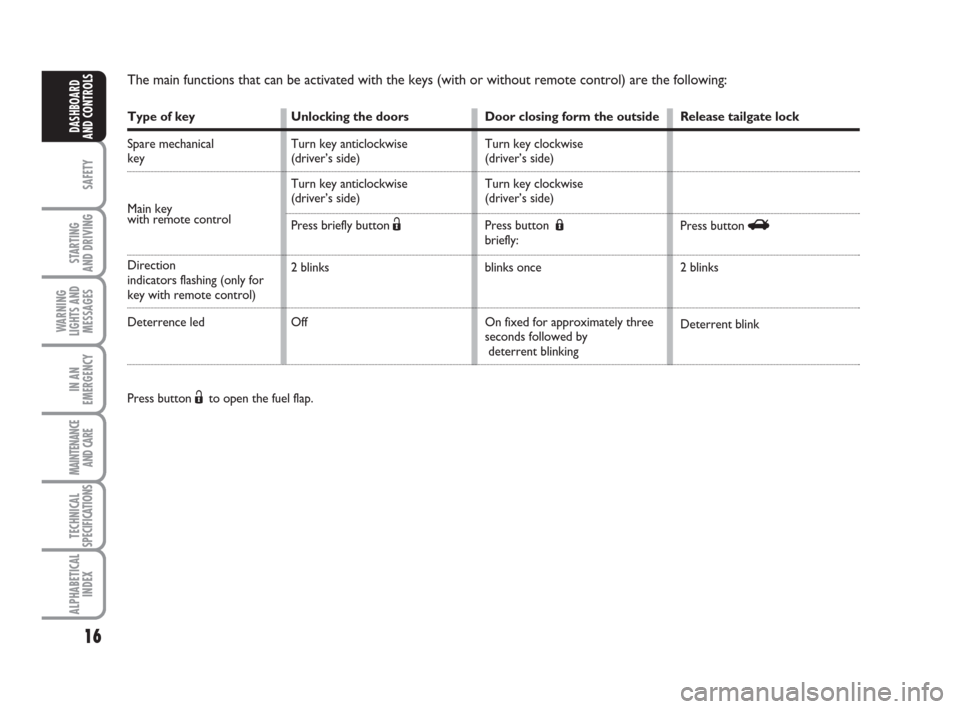
16
SAFETY
STARTING
AND DRIVING
WARNING
LIGHTS AND
MESSAGES
IN AN
EMERGENCY
MAINTENANCE
AND CARE
TECHNICAL
SPECIFICATIONS
ALPHABETICAL
INDEX
DASHBOARD
AND CONTROLS
The main functions that can be activated with the keys (with or without remote control) are the following:
Press button Ëto open the fuel flap.
Type of key
Spare mechanical
key
Main key
with remote control
Direction
indicators flashing (only for
key with remote control)
Deterrence led
Release tailgate lock
Press button R
2 blinks
Deterrent blink Unlocking the doors
Turn key anticlockwise
(driver’s side)
Turn key anticlockwise
(driver’s side)
Press briefly button Ë
2 blinks
OffDoor closing form the outside
Turn key clockwise
(driver’s side)
Turn key clockwise
(driver’s side)
Press button Á
briefly:
blinks once
On fixed for approximately three
seconds followed by
deterrent blinking
Page 35 of 210
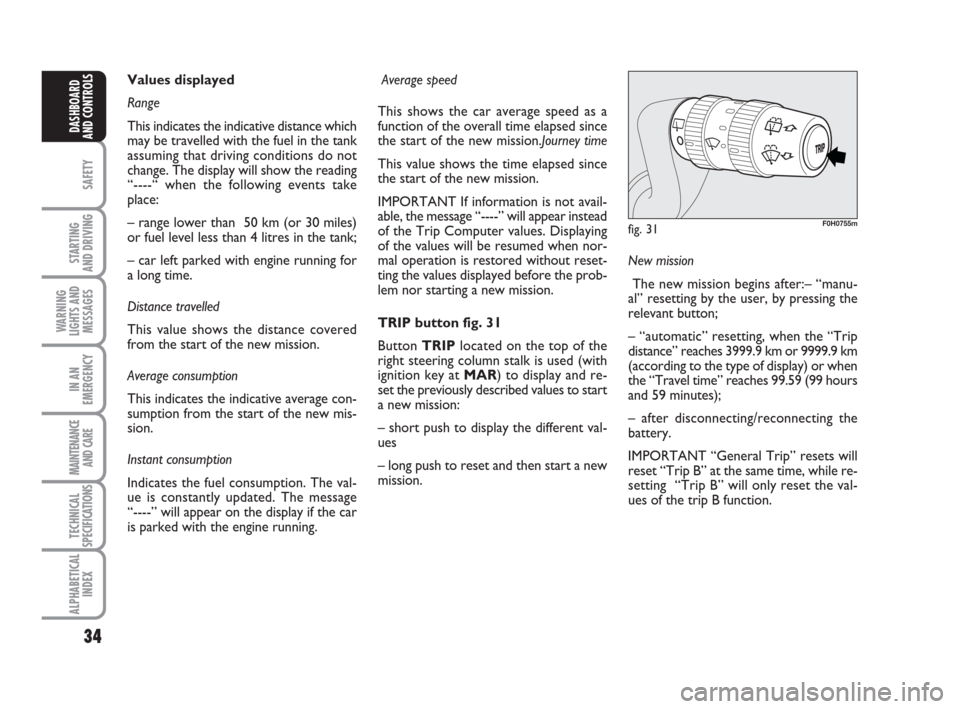
34
SAFETY
STARTING
AND DRIVING
WARNING
LIGHTS AND
MESSAGES
IN AN
EMERGENCY
MAINTENANCE
AND CARE
TECHNICAL
SPECIFICATIONS
ALPHABETICAL
INDEX
DASHBOARD
AND CONTROLS
New mission
The new mission begins after:– “manu-
al” resetting by the user, by pressing the
relevant button;
– “automatic” resetting, when the “Trip
distance” reaches 3999.9 km or 9999.9 km
(according to the type of display) or when
the “Travel time” reaches 99.59 (99 hours
and 59 minutes);
– after disconnecting/reconnecting the
battery.
IMPORTANT “General Trip” resets will
reset “Trip B” at the same time, while re-
setting “Trip B” will only reset the val-
ues of the trip B function. Average speed
This shows the car average speed as a
function of the overall time elapsed since
the start of the new mission.Journey time
This value shows the time elapsed since
the start of the new mission.
IMPORTANT If information is not avail-
able, the message “----” will appear instead
of the Trip Computer values. Displaying
of the values will be resumed when nor-
mal operation is restored without reset-
ting the values displayed before the prob-
lem nor starting a new mission.
TRIP button fig. 31
Button TRIPlocated on the top of the
right steering column stalk is used (with
ignition key at MAR) to display and re-
set the previously described values to start
a new mission:
– short push to display the different val-
ues
– long push to reset and then start a new
mission. Values displayed
Range
This indicates the indicative distance which
may be travelled with the fuel in the tank
assuming that driving conditions do not
change. The display will show the reading
“----“ when the following events take
place:
– range lower than 50 km (or 30 miles)
or fuel level less than 4 litres in the tank;
– car left parked with engine running for
a long time.
Distance travelled
This value shows the distance covered
from the start of the new mission.
Average consumption
This indicates the indicative average con-
sumption from the start of the new mis-
sion.
Instant consumption
Indicates the fuel consumption. The val-
ue is constantly updated. The message
“----” will appear on the display if the car
is parked with the engine running.
fig. 31F0H0755m
Page 91 of 210
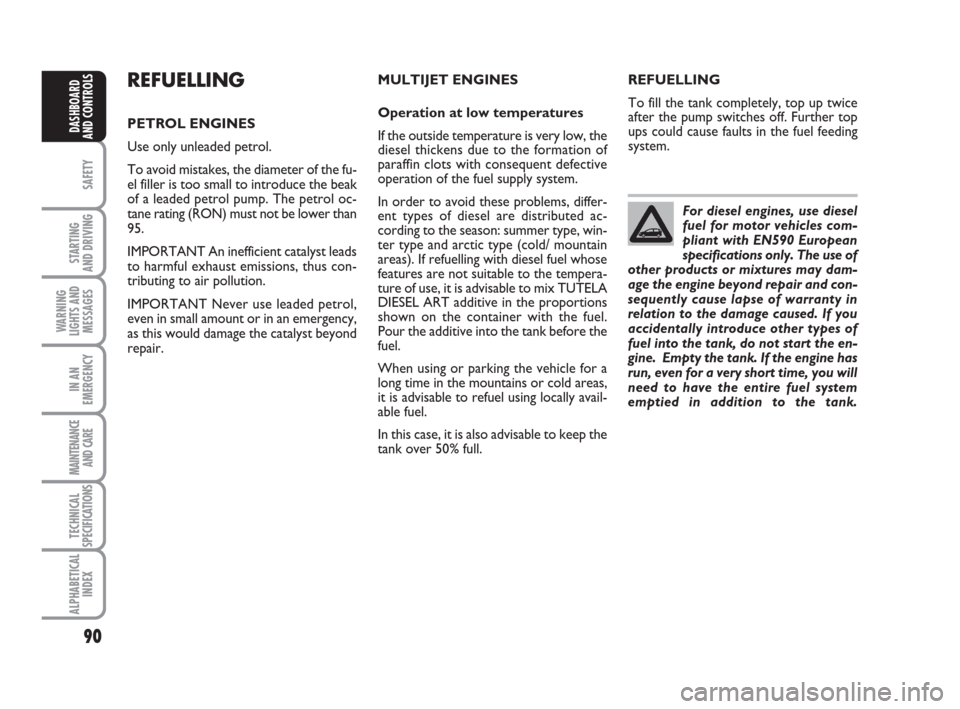
90
SAFETY
STARTING
AND DRIVING
WARNING
LIGHTS AND
MESSAGES
IN AN
EMERGENCY
MAINTENANCE
AND CARE
TECHNICAL
SPECIFICATIONS
ALPHABETICAL
INDEX
DASHBOARD
AND CONTROLS
For diesel engines, use diesel
fuel for motor vehicles com-
pliant with EN590 European
specifications only. The use of
other products or mixtures may dam-
age the engine beyond repair and con-
sequently cause lapse of warranty in
relation to the damage caused. If you
accidentally introduce other types of
fuel into the tank, do not start the en-
gine. Empty the tank. If the engine has
run, even for a very short time, you will
need to have the entire fuel system
emptied in addition to the tank.
REFUELLING
PETROL ENGINES
Use only unleaded petrol.
To avoid mistakes, the diameter of the fu-
el filler is too small to introduce the beak
of a leaded petrol pump. The petrol oc-
tane rating (RON) must not be lower than
95.
IMPORTANT An inefficient catalyst leads
to harmful exhaust emissions, thus con-
tributing to air pollution.
IMPORTANT Never use leaded petrol,
even in small amount or in an emergency,
as this would damage the catalyst beyond
repair.MULTIJET ENGINES
Operation at low temperatures
If the outside temperature is very low, the
diesel thickens due to the formation of
paraffin clots with consequent defective
operation of the fuel supply system.
In order to avoid these problems, differ-
ent types of diesel are distributed ac-
cording to the season: summer type, win-
ter type and arctic type (cold/ mountain
areas). If refuelling with diesel fuel whose
features are not suitable to the tempera-
ture of use, it is advisable to mix TUTELA
DIESEL ART additive in the proportions
shown on the container with the fuel.
Pour the additive into the tank before the
fuel.
When using or parking the vehicle for a
long time in the mountains or cold areas,
it is advisable to refuel using locally avail-
able fuel.
In this case, it is also advisable to keep the
tank over 50% full.REFUELLING
To fill the tank completely, top up twice
after the pump switches off. Further top
ups could cause faults in the fuel feeding
system.
Page 93 of 210
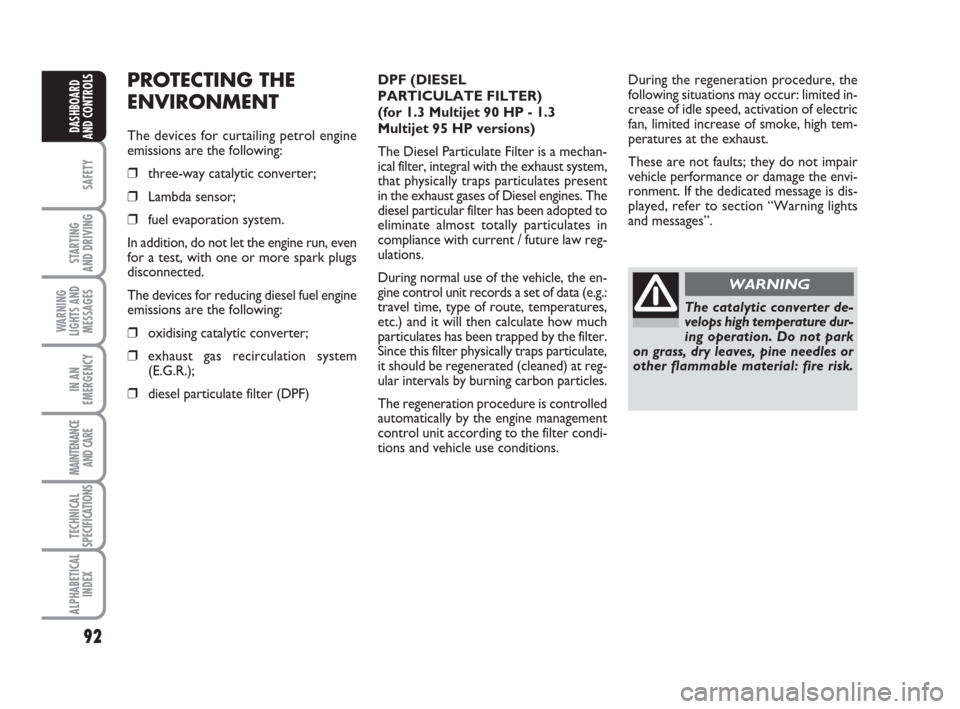
92
SAFETY
STARTING
AND DRIVING
WARNING
LIGHTS AND
MESSAGES
IN AN
EMERGENCY
MAINTENANCE
AND CARE
TECHNICAL
SPECIFICATIONS
ALPHABETICAL
INDEX
DASHBOARD
AND CONTROLS
PROTECTING THE
ENVIRONMENT
The devices for curtailing petrol engine
emissions are the following:
❒three-way catalytic converter;
❒Lambda sensor;
❒fuel evaporation system.
In addition, do not let the engine run, even
for a test, with one or more spark plugs
disconnected.
The devices for reducing diesel fuel engine
emissions are the following:
❒oxidising catalytic converter;
❒exhaust gas recirculation system
(E.G.R.);
❒diesel particulate filter (DPF)DPF (DIESEL
PARTICULATE FILTER)
(for 1.3 Multijet 90 HP - 1.3
Multijet 95 HP versions)
The Diesel Particulate Filter is a mechan-
ical filter, integral with the exhaust system,
that physically traps particulates present
in the exhaust gases of Diesel engines. The
diesel particular filter has been adopted to
eliminate almost totally particulates in
compliance with current / future law reg-
ulations.
During normal use of the vehicle, the en-
gine control unit records a set of data (e.g.:
travel time, type of route, temperatures,
etc.) and it will then calculate how much
particulates has been trapped by the filter.
Since this filter physically traps particulate,
it should be regenerated (cleaned) at reg-
ular intervals by burning carbon particles.
The regeneration procedure is controlled
automatically by the engine management
control unit according to the filter condi-
tions and vehicle use conditions.
The catalytic converter de-
velops high temperature dur-
ing operation. Do not park
on grass, dry leaves, pine needles or
other flammable material: fire risk.
WARNING
During the regeneration procedure, the
following situations may occur: limited in-
crease of idle speed, activation of electric
fan, limited increase of smoke, high tem-
peratures at the exhaust.
These are not faults; they do not impair
vehicle performance or damage the envi-
ronment. If the dedicated message is dis-
played, refer to section “Warning lights
and messages”.
Page 118 of 210
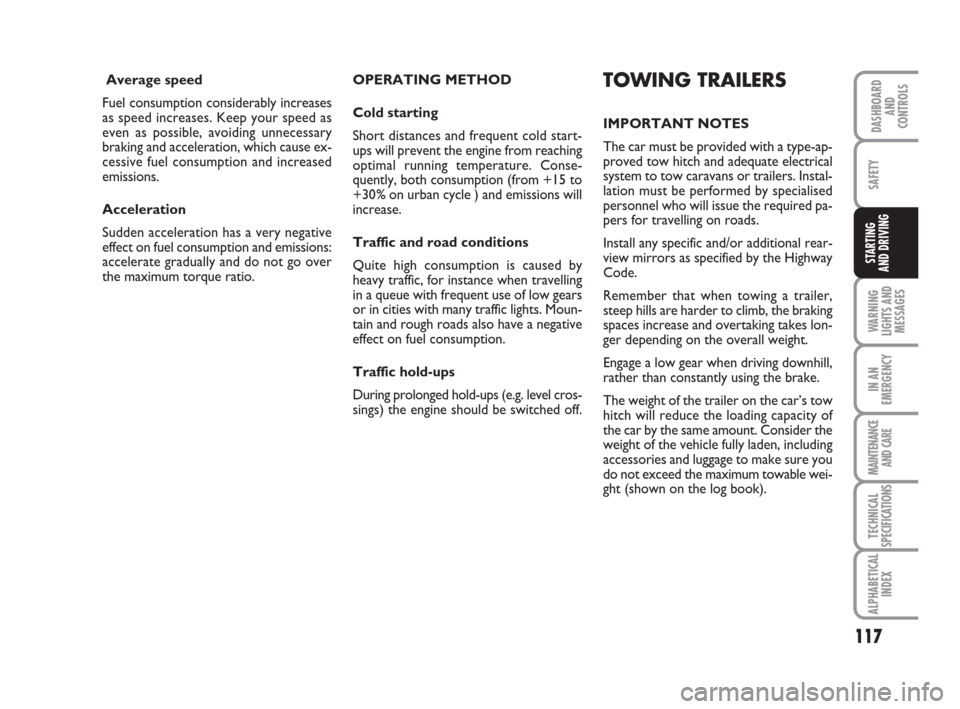
117
WARNING
LIGHTS AND
MESSAGES
IN AN
EMERGENCY
MAINTENANCE
AND CARE
TECHNICAL
SPECIFICATIONS
ALPHABETICAL
INDEX
DASHBOARD
AND
CONTROLS
SAFETY
STARTING
AND DRIVING
Average speed
Fuel consumption considerably increases
as speed increases. Keep your speed as
even as possible, avoiding unnecessary
braking and acceleration, which cause ex-
cessive fuel consumption and increased
emissions.
Acceleration
Sudden acceleration has a very negative
effect on fuel consumption and emissions:
accelerate gradually and do not go over
the maximum torque ratio.OPERATING METHOD
Cold starting
Short distances and frequent cold start-
ups will prevent the engine from reaching
optimal running temperature. Conse-
quently, both consumption (from +15 to
+30% on urban cycle ) and emissions will
increase.
Traffic and road conditions
Quite high consumption is caused by
heavy traffic, for instance when travelling
in a queue with frequent use of low gears
or in cities with many traffic lights. Moun-
tain and rough roads also have a negative
effect on fuel consumption.
Traffic hold-ups
During prolonged hold-ups (e.g. level cros-
sings) the engine should be switched off.TOWING TRAILERS
IMPORTANT NOTES
The car must be provided with a type-ap-
proved tow hitch and adequate electrical
system to tow caravans or trailers. Instal-
lation must be performed by specialised
personnel who will issue the required pa-
pers for travelling on roads.
Install any specific and/or additional rear-
view mirrors as specified by the Highway
Code.
Remember that when towing a trailer,
steep hills are harder to climb, the braking
spaces increase and overtaking takes lon-
ger depending on the overall weight.
Engage a low gear when driving downhill,
rather than constantly using the brake.
The weight of the trailer on the car’s tow
hitch will reduce the loading capacity of
the car by the same amount. Consider the
weight of the vehicle fully laden, including
accessories and luggage to make sure you
do not exceed the maximum towable wei-
ght (shown on the log book).
Page 186 of 210
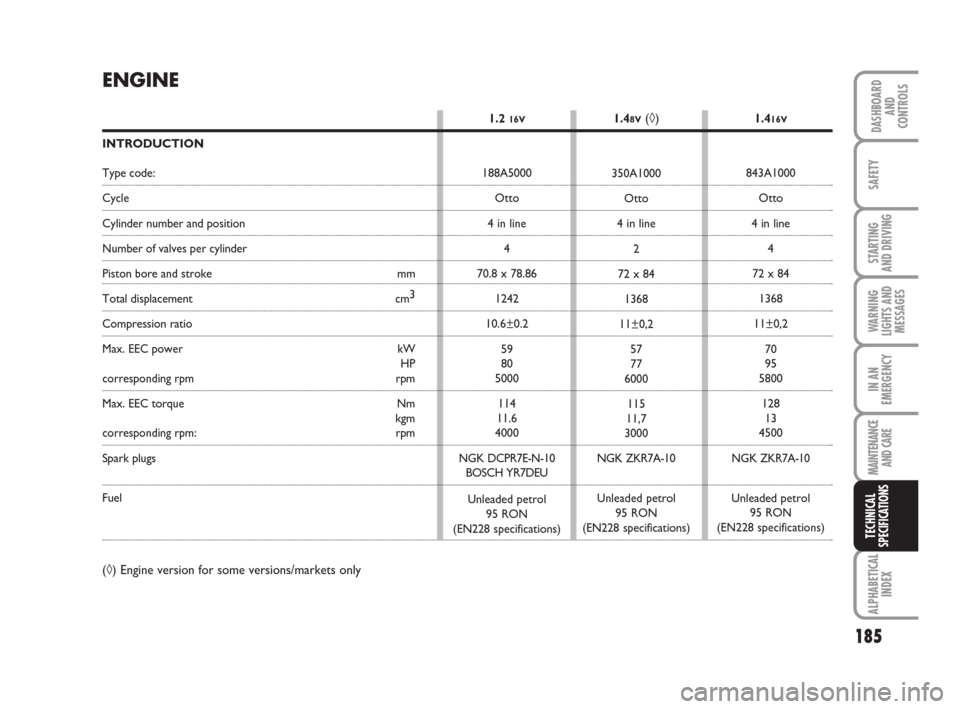
185
STARTING
AND DRIVING
IN AN
EMERGENCY
MAINTENANCE
AND CARE
ALPHABETICAL
INDEX
DASHBOARD
AND
CONTROLS
SAFETY
WARNING
LIGHTS AND
MESSAGES
TECHNICAL
SPECIFICATIONS
(◊) Engine version for some versions/markets only
ENGINE
INTRODUCTION
Type code:
Cycle
Cylinder number and position
Number of valves per cylinder
Piston bore and stroke mm
Total displacement cm3
Compression ratio
Max. EEC power kW
HP
corresponding rpm rpm
Max. EEC torque Nm
kgm
corresponding rpm: rpm
Spark plugs
Fuel
1.2 16V
188A5000
Otto
4 in line
4
70.8 x 78.86
1242
10.6±0.2
59
80
5000
114
11.6
4000
NGK DCPR7E-N-10
BOSCH YR7DEU
Unleaded petrol
95 RON
(EN228 specifications)1.4
16V
843A1000
Otto
4 in line
4
72 x 84
1368
11±0,2
70
95
5800
128
13
4500
NGK ZKR7A-10
Unleaded petrol
95 RON
(EN228 specifications) 1.4
8V(◊)
350A1000
Otto
4 in line
2
72 x 84
1368
11±0,2
57
77
6000
115
11,7
3000
NGK ZKR7A-10
Unleaded petrol
95 RON
(EN228 specifications)
Page 187 of 210
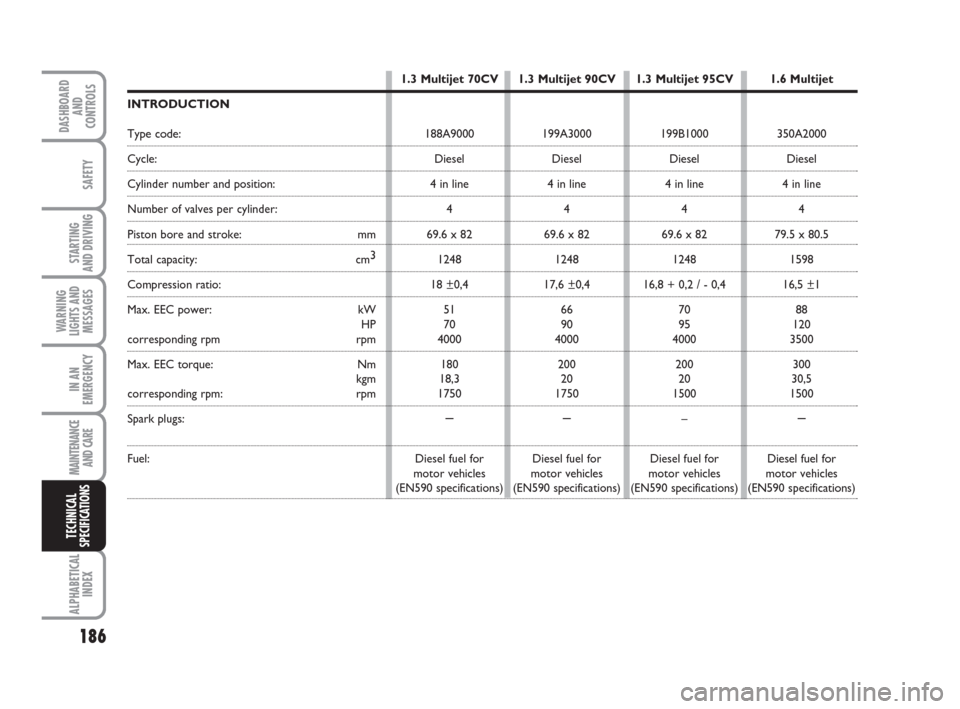
186
STARTING
AND DRIVING
IN AN
EMERGENCY
MAINTENANCE
AND CARE
ALPHABETICAL
INDEX
DASHBOARD
AND
CONTROLS
SAFETY
WARNING
LIGHTS AND
MESSAGES
TECHNICAL
SPECIFICATIONS
INTRODUCTION
Type code:
Cycle:
Cylinder number and position:
Number of valves per cylinder:
Piston bore and stroke: mm
Total capacity: cm3
Compression ratio:
Max. EEC power: kW
HP
corresponding rpm rpm
Max. EEC torque: Nm
kgm
corresponding rpm: rpm
Spark plugs:
Fuel:
1.6 Multijet
350A2000
Diesel
4 in line
4
79.5 x 80.5
1598
16,5 ±1
88
120
3500
300
30,5
1500
–
Diesel fuel for
motor vehicles
(EN590 specifications) 1.3 Multijet 90CV
199A3000
Diesel
4 in line
4
69.6 x 82
1248
17,6 ±0,4
66
90
4000
200
20
1750
–
Diesel fuel for
motor vehicles
(EN590 specifications) 1.3 Multijet 70CV
188A9000
Diesel
4 in line
4
69.6 x 82
1248
18 ±0,4
51
70
4000
180
18,3
1750
–
Diesel fuel for
motor vehicles
(EN590 specifications)1.3 Multijet 95CV
199B1000
Diesel
4 in line
4
69.6 x 82
1248
16,8 + 0,2 / - 0,4
70
95
4000
200
20
1500
–
Diesel fuel for
motor vehicles
(EN590 specifications)
Page 198 of 210
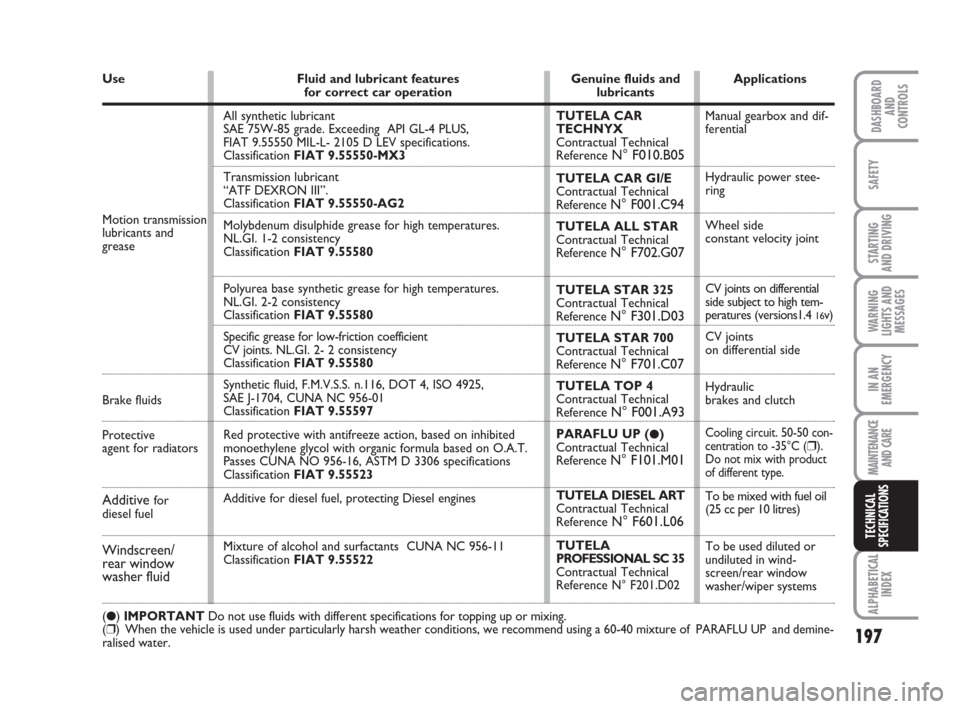
197
STARTING
AND DRIVING
IN AN
EMERGENCY
MAINTENANCE
AND CARE
ALPHABETICAL
INDEX
DASHBOARD
AND
CONTROLS
SAFETY
WARNING
LIGHTS AND
MESSAGES
TECHNICAL
SPECIFICATIONS
Use
Motion transmission
lubricants and
grease
Brake fluids
Protective
agent for radiators
Additive for
diesel fuel
Windscreen/
rear window
washer fluid
(●)IMPORTANT Do not use fluids with different specifications for topping up or mixing.
(❒) When the vehicle is used under particularly harsh weather conditions, we recommend using a 60-40 mixture of PARAFLU UP and demine-
ralised water.Fluid and lubricant features
for correct car operation
All synthetic lubricant
SAE 75W-85 grade. Exceeding API GL-4 PLUS,
FIAT 9.55550 MIL-L- 2105 D LEV specifications.
ClassificationFIAT 9.55550-MX3
Transmission lubricant
“ATF DEXRON III”.
ClassificationFIAT 9.55550-AG2
Molybdenum disulphide grease for high temperatures.
NL.GI. 1-2 consistency
ClassificationFIAT 9.55580
Polyurea base synthetic grease for high temperatures.
NL.GI. 2-2 consistency
ClassificationFIAT 9.55580
Specific grease for low-friction coefficient
CV joints. NL.GI. 2- 2 consistency
ClassificationFIAT 9.55580
Synthetic fluid, F.M.V.S.S. n.116, DOT 4, ISO 4925,
SAE J-1704, CUNA NC 956-01
Classification FIAT 9.55597
Red protective with antifreeze action, based on inhibited
monoethylene glycol with organic formula based on O.A.T.
Passes CUNA NO 956-16, ASTM D 3306 specifications
Classification FIAT 9.55523
Additive for diesel fuel, protecting Diesel engines
Mixture of alcohol and surfactants CUNA NC 956-11
Classification FIAT 9.55522Genuine fluids and
lubricants
TUTELA CAR
TECHNYX
Contractual Technical
Reference
N° F010.B05
TUTELA CAR GI/E
Contractual Technical
Reference
N° F001.C94
TUTELA ALL STAR
Contractual Technical
Reference
N° F702.G07
TUTELA STAR 325
Contractual Technical
Reference
N° F301.D03
TUTELA STAR 700
Contractual Technical
Reference
N° F701.C07
TUTELA TOP 4
Contractual Technical
Reference
N° F001.A93
PARAFLU UP (●)
Contractual Technical
Reference
N° F101.M01
TUTELA DIESEL ART
Contractual Technical
Reference
N° F601.L06
TUTELA
PROFESSIONAL SC 35
Contractual Technical
Reference N° F201.D02Applications
Manual gearbox and dif-
ferential
Hydraulic power stee-
ring
Wheel side
constant velocity joint
CV joints on differential
side subject to high tem-
peratures (versions1.4
16v)
CV joints
on differential side
Hydraulic
brakes and clutch
Cooling circuit. 50-50 con-
centration to -35°C (❒).
Do not mix with product
of different type.
To be mixed with fuel oil
(25 cc per 10 litres)
To be used diluted or
undiluted in wind-
screen/rear window
washer/wiper systems
Page 199 of 210

198
STARTING
AND DRIVING
IN AN
EMERGENCY
MAINTENANCE
AND CARE
ALPHABETICAL
INDEX
DASHBOARD
AND
CONTROLS
SAFETY
WARNING
LIGHTS AND
MESSAGES
TECHNICAL
SPECIFICATIONS
FUEL CONSUMPTION
The fuel consumption figures given in the table below are determined on the basis of the homologation tests laid down by specific
European Directives.
The procedures below are followed for measuring consumption:
❒urban cycle: cold starting followed by driving that simulates urban use of the car;
❒extra urban cycle: driving simulating the use of the vehicle in a non-urban situation with frequent acceleration in all gears; the
speed varies between 0 and 120 km/h;
❒combined consumption: about 37% of the urban cycle and around 63% of the non-urban cycle.
IMPORTANT The type of route, traffic situations, weather conditions, driving style, general conditions of the car, trim level/
equipment/accessories, load, climate control system, roof rack, other situations that affect air drag may lead to different fuel con-
sumption levels than those measured.
According to European Directive in force (litres per 100 km) Urban Extra urban Combined
1.216V8.4 5.4 6.5
1.48V(◊) 7.9 5.1 6.1
1.416V (5 gears) 8.5 5.5 6.6
1.416V (6 gears) 8.5 4.8 6.2
1.3 Multijet 70CV 5.8 4.1 4.7
1.3 Multijet 90CV 5.8 3.9 4.6
1.3 Multijet 95CV 5,7 3,8 4,5
1.6 Multijet 6.0 4.0 4.7
(◊) Engine version for some versions/markets only